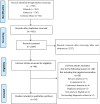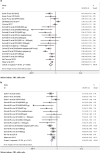Prenatal Folic Acid Supplements and Offspring's Autism Spectrum Disorder: A Meta-analysis and Meta-regression
- PMID: 33743119
- PMCID: PMC8813730
- DOI: 10.1007/s10803-021-04951-8
Prenatal Folic Acid Supplements and Offspring's Autism Spectrum Disorder: A Meta-analysis and Meta-regression
Abstract
We systematically reviewed the evidence on the association between maternal folic acid supplementation and the risk of offspring's autism spectrum disorders (ASD). A total of 10 studies with 23 sub-studies (9795 ASD cases) were included. Folic acid supplementation during early pregnancy was associated with a lower risk of offspring's ASD [OR 0.57, 95% CI 0.41-0.78]. The consumption of a daily amount of at least 400 μg folic acid from dietary sources and supplements, was associated with a reduced risk of offspring ASD [OR 0.55, 95% CI 0.36-0.83]. Critical effective maternal folic acid supplementation strategies, such as intake timing and intake dosage, may aid the reduction in the risk of offspring ASD. This meta-analysis provided new insights for the prevention of offspring's ASD.
Keywords: Autism spectrum disorder; Folic acid; Meta-analysis; Meta-regression; Prenatal.
© 2021. The Author(s).
Conflict of interest statement
The authors declare that they have no competing interests.
Figures








References
-
- Al-Farsi YM, Waly MI, Deth RC, Al-Sharbati MM, Al-Shafaee M, Al-Farsi O, Al-Khaduri MM, Gupta I, Ali A, Al-Khalili M, Al-Adawi S. Low folate and vitamin B12 nourishment is common in Omani children with newly diagnosed autism. Nutrition. 2013;29(3):537–541. doi: 10.1016/j.nut.2012.09.014. - DOI - PubMed
-
- American Psychiatric Association . Diagnostic and statistical manual of mental disorders. American Psychiatric Association; 2013.
-
- Bahous RH, Jadavji NM, Deng L, Cosín-Tomás M, Lu J, Malysheva O, Leung KY, Ho MK, Pallàs M, Kaliman P, Greene ND. High dietary folate in pregnant mice leads to pseudo-MTHFR deficiency and altered methyl metabolism, with embryonic growth delay and short-term memory impairment in offspring. Human Molecular Genetics. 2017;26(5):888–900. doi: 10.1093/hmg/ddx004. - DOI - PMC - PubMed
-
- Bailey S, Ayling JE. The extremely slow and variable activity of dihydrofolate reductase in human liver and its implications for high folic acid intake. Proceedings of the National Academy of Sciences of the United States of America. 2009;106(37):15424–15429. doi: 10.1073/pnas.0902072106. - DOI - PMC - PubMed
Publication types
MeSH terms
Substances
Grants and funding
- 2016A020215019/Science and Technology Department of Guangdong Province of China
- YIP-2018-049/the fund from Guangzhou Institute of Pediatrics, Guangzhou Women and Children's Medical Center
- 2016YFC1306205/the key projects fund of Ministry of science and technology of China
- 2019A011028/Science and technology project of Guangzhou Municipal Health Commission
LinkOut - more resources
Full Text Sources
Other Literature Sources
Medical

